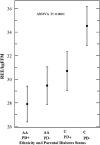Parental history of type 2 diabetes is associated with lower resting energy expenditure in normoglycemic subjects
- PMID: 29892337
- PMCID: PMC5992470
- DOI: 10.1136/bmjdrc-2018-000511
Parental history of type 2 diabetes is associated with lower resting energy expenditure in normoglycemic subjects
Abstract
Objective: Resting energy expenditure (REE) is linked to obesity, insulin resistance and type 2 diabetes (T2DM). REE and T2DM are inherited traits. Therefore, we investigated the effect of parental T2DM on REE in normoglycemic subjects.
Methods: Eighty-seven subjects with parental T2DM and 83 subjects without parental T2DM were matched in age, gender, race, BMI, weight and waist circumference. Subjects underwent a 75 g oral glucose tolerance test; REE was determined by indirect calorimetry and body composition was assessed by dual energy X-ray absorptiometry. Statistical analysis was performed using Student's t-test, analysis of variance and regression analysis.
Results: The mean age was 38.8±11.3 years, 57% were females and 53% were African-Americans. The mean BMI was 28.5±6.1 kg/m2, waist circumference 91.8±15.1 cm, weight 83.9±20.3 kg, fat mass 31.0%±10.0%, mean fat-free mass (FFM) 54.4±12.9 kg. REE was significantly lower in subjects with parental diabetes, normalized REE 1364.4±263.4Kcal/day vs 1489.4±323.2 Kcal/day, p=0.006 and 29.2±5.3Kcal/kg FFM/day vs 31.9±6.0 Kcal/kg FFM/day, p=0.002. African-Americans had a lower REE compared with Caucasians 28.6±5.4Kcal/kg FFM/day vs 32.6±5.5 Kcal/kg FFM/day, p<0.0001. In a multiple regression model, ethnicity (p<0.0001), parental history of T2DM (p=0.006) and FFM (p=0.021) were independent predictors of REE.
Conclusion: Compared with subjects without parental diabetes, offspring with parental T2DM had lower REE, which was more pronounced in African-Americans. This metabolic alteration could increase the risk of obesity, insulin resistance and dysglycemia.
Keywords: energy expenditure and obesity; insulin resistance; type 2 diabetes.
Conflict of interest statement
Competing interests: None declared.
Figures
Similar articles
-
Determinants of increased energy expenditure in HIV-infected women.Am J Clin Nutr. 1998 Sep;68(3):720-5. doi: 10.1093/ajcn/68.3.720. Am J Clin Nutr. 1998. PMID: 9734753
-
Influence of fat-free mass and functional status on resting energy expenditure in underweight elders.J Gerontol A Biol Sci Med Sci. 2002 May;57(5):M302-7. doi: 10.1093/gerona/57.5.m302. J Gerontol A Biol Sci Med Sci. 2002. PMID: 11983724
-
Predictive equations for estimating resting energy expenditure in women with overweight and obesity at three postpartum stages.J Nutr Sci. 2020 Aug 7;9:e31. doi: 10.1017/jns.2020.16. eCollection 2020. J Nutr Sci. 2020. PMID: 32913643 Free PMC article.
-
Effect of organ and tissue masses on resting energy expenditure in underweight, normal weight and obese adults.Int J Obes Relat Metab Disord. 2004 Jan;28(1):72-9. doi: 10.1038/sj.ijo.0802526. Int J Obes Relat Metab Disord. 2004. PMID: 14647174
-
Resting energy expenditure in type 2 diabetic patients and the effect of insulin bolus.Diabetes Res Clin Pract. 2014 Dec;106(3):605-10. doi: 10.1016/j.diabres.2014.09.016. Epub 2014 Oct 2. Diabetes Res Clin Pract. 2014. PMID: 25312871
Cited by
-
Total energy expenditure is comparable between patients with and without diabetes mellitus: Clinical Evaluation of Energy Requirements in Patients with Diabetes Mellitus (CLEVER-DM) Study.BMJ Open Diabetes Res Care. 2019 Mar 25;7(1):e000648. doi: 10.1136/bmjdrc-2019-000648. eCollection 2019. BMJ Open Diabetes Res Care. 2019. PMID: 31114702 Free PMC article.
-
Association between MIC-1 and Type 2 Diabetes: A Combined Analysis.Dis Markers. 2019 Nov 16;2019:7284691. doi: 10.1155/2019/7284691. eCollection 2019. Dis Markers. 2019. PMID: 31827641 Free PMC article. Review.
-
Time to Development of Overt Diabetes and Macrovascular and Microvascular Complications Among Patients With Prediabetes: A Retrospective Cohort Study.Cureus. 2021 Dec 1;13(12):e20079. doi: 10.7759/cureus.20079. eCollection 2021 Dec. Cureus. 2021. PMID: 34987939 Free PMC article.
-
Plasma Sphingolipid Profile of Healthy Black and White Adults Differs Based on Their Parental History of Type 2 Diabetes.J Clin Endocrinol Metab. 2024 Feb 20;109(3):740-749. doi: 10.1210/clinem/dgad595. J Clin Endocrinol Metab. 2024. PMID: 37804534 Free PMC article.
-
Exercise-Induced Improvements in Insulin Sensitivity Are Not Attenuated by a Family History of Type 2 Diabetes.Front Endocrinol (Lausanne). 2020 Mar 13;11:120. doi: 10.3389/fendo.2020.00120. eCollection 2020. Front Endocrinol (Lausanne). 2020. PMID: 32231642 Free PMC article. Clinical Trial.
References
Grants and funding
LinkOut - more resources
Full Text Sources
Other Literature Sources

